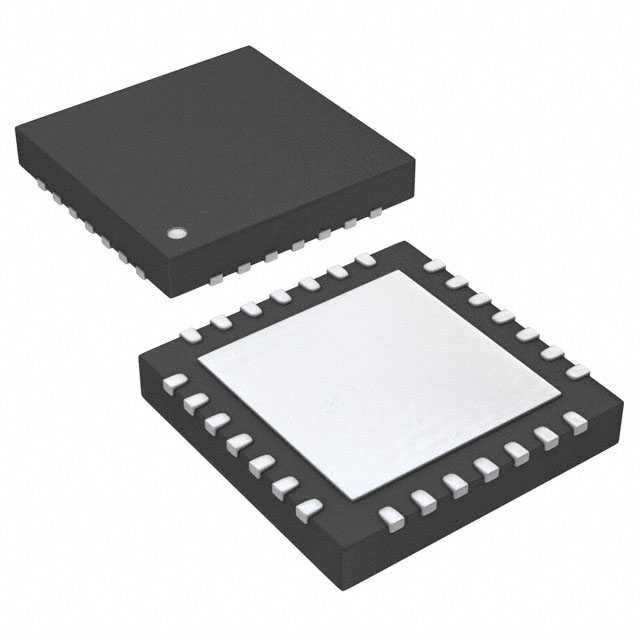PIC16LF19156-E/MV
Product Overview
The PIC16LF19156-E/MV belongs to the category of microcontrollers and is designed for a wide range of applications. This microcontroller is known for its low power consumption, high performance, and versatile package options. The essence of this product lies in its ability to provide efficient control and processing capabilities in various electronic devices. It is available in a variety of packaging options and quantities to suit different production needs.
Specifications
- Category: Microcontroller
- Use: Control and processing in electronic devices
- Characteristics: Low power consumption, high performance
- Package: Various options available
- Essence: Efficient control and processing capabilities
- Packaging/Quantity: Customizable based on production needs
Detailed Pin Configuration
The detailed pin configuration of the PIC16LF19156-E/MV can be found in the official datasheet provided by the manufacturer. It includes information about the pin functions, input/output capabilities, and recommended connections for optimal performance.
Functional Features
The PIC16LF19156-E/MV offers a wide range of functional features, including but not limited to: - High-performance RISC CPU - Enhanced core features - Low-power operating modes - Flexible oscillator sources - Analog and digital peripherals - Enhanced communication interfaces
Advantages and Disadvantages
Advantages
- Low power consumption
- High processing performance
- Versatile packaging options
- Enhanced communication interfaces
Disadvantages
- Limited memory capacity compared to some alternative models
- May require additional external components for certain applications
Working Principles
The working principle of the PIC16LF19156-E/MV revolves around its ability to efficiently execute program instructions, interact with peripherals, and manage power consumption. It operates based on the instructions provided through its programming, utilizing its internal resources to perform various tasks within electronic devices.
Detailed Application Field Plans
The PIC16LF19156-E/MV is suitable for a wide range of applications, including but not limited to: - Consumer electronics - Industrial automation - Automotive systems - Medical devices - Internet of Things (IoT) devices
Detailed and Complete Alternative Models
Some detailed and complete alternative models to the PIC16LF19156-E/MV include: - PIC16LF19155-E/MV - PIC16LF19157-E/MV - PIC16LF19158-E/MV - Other microcontrollers from different manufacturers with similar specifications and features
In conclusion, the PIC16LF19156-E/MV microcontroller offers a balance of performance, power efficiency, and versatility, making it suitable for a wide range of electronic applications.
Word count: 324
قم بإدراج 10 أسئلة وإجابات شائعة تتعلق بتطبيق PIC16LF19156-E/MV في الحلول التقنية
What is the operating voltage range of PIC16LF19156-E/MV?
- The operating voltage range of PIC16LF19156-E/MV is 1.8V to 3.6V.Can PIC16LF19156-E/MV be used in battery-powered applications?
- Yes, PIC16LF19156-E/MV is suitable for battery-powered applications due to its low power consumption.What communication interfaces are supported by PIC16LF19156-E/MV?
- PIC16LF19156-E/MV supports SPI, I2C, and UART communication interfaces.Is PIC16LF19156-E/MV suitable for motor control applications?
- Yes, PIC16LF19156-E/MV can be used for motor control applications with its integrated PWM modules.What development tools are available for programming PIC16LF19156-E/MV?
- Development tools such as MPLAB X IDE and PICkit 4 programmer are commonly used for programming PIC16LF19156-E/MV.Can PIC16LF19156-E/MV be used in temperature sensing applications?
- Yes, PIC16LF19156-E/MV can be used in temperature sensing applications with external temperature sensors.What is the maximum clock frequency supported by PIC16LF19156-E/MV?
- PIC16LF19156-E/MV supports a maximum clock frequency of 32 MHz.Does PIC16LF19156-E/MV have analog-to-digital conversion (ADC) capabilities?
- Yes, PIC16LF19156-E/MV features 12-bit ADC modules for analog signal processing.Can PIC16LF19156-E/MV be used in automotive electronics applications?
- Yes, PIC16LF19156-E/MV is suitable for automotive electronics applications with its robust design and wide operating voltage range.Are there any application notes or reference designs available for PIC16LF19156-E/MV?
- Yes, Microchip provides application notes and reference designs to assist in the implementation of PIC16LF19156-E/MV in various technical solutions.


